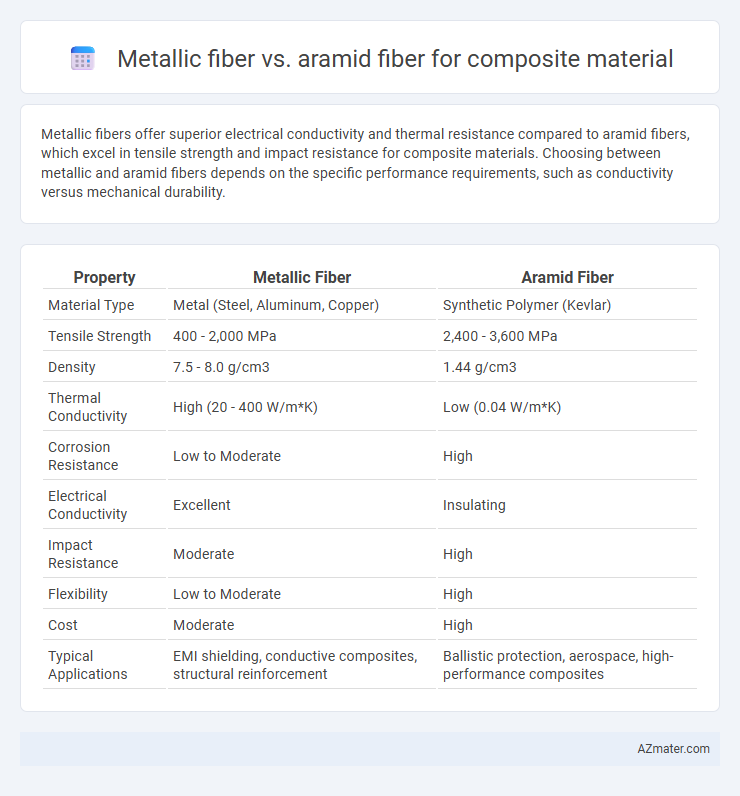Metallic fibers offer superior electrical conductivity and thermal resistance compared to aramid fibers, which excel in tensile strength and impact resistance for composite materials. Choosing between metallic and aramid fibers depends on the specific performance requirements, such as conductivity versus mechanical durability.
Table of Comparison
| Property | Metallic Fiber | Aramid Fiber |
|---|---|---|
| Material Type | Metal (Steel, Aluminum, Copper) | Synthetic Polymer (Kevlar) |
| Tensile Strength | 400 - 2,000 MPa | 2,400 - 3,600 MPa |
| Density | 7.5 - 8.0 g/cm3 | 1.44 g/cm3 |
| Thermal Conductivity | High (20 - 400 W/m*K) | Low (0.04 W/m*K) |
| Corrosion Resistance | Low to Moderate | High |
| Electrical Conductivity | Excellent | Insulating |
| Impact Resistance | Moderate | High |
| Flexibility | Low to Moderate | High |
| Cost | Moderate | High |
| Typical Applications | EMI shielding, conductive composites, structural reinforcement | Ballistic protection, aerospace, high-performance composites |
Introduction to Composite Materials
Metallic fibers provide excellent electrical conductivity and enhanced fracture toughness in composite materials, making them ideal for electromagnetic interference shielding and structural reinforcement. Aramid fibers, known for their exceptional tensile strength and resistance to heat and abrasion, are widely used to improve impact resistance and durability in composites such as ballistic armor and aerospace components. Both fibers contribute uniquely to composite performance, optimizing mechanical properties and multifunctionality depending on the application requirements.
Overview of Metallic Fibers
Metallic fibers in composite materials offer exceptional electrical conductivity, high thermal resistance, and enhanced mechanical strength compared to aramid fibers, which are primarily valued for their impact resistance and lightweight properties. These fibers, typically made from stainless steel, aluminum, or copper, improve composite durability in extreme environments while providing electromagnetic interference (EMI) shielding. Their integration into composites enables applications requiring both structural reinforcement and functional performance such as aerospace components and electronic enclosures.
Overview of Aramid Fibers
Aramid fibers, such as Kevlar, are high-performance synthetic fibers known for exceptional tensile strength, thermal stability, and resistance to abrasion, making them ideal for composite materials in aerospace and personal protective equipment. Compared to metallic fibers, aramid fibers offer superior impact resistance and lightweight characteristics, enhancing composite durability without adding significant weight. Their molecular structure consists of aromatic polyamide chains that provide excellent chemical resistance and maintain integrity under mechanical stress.
Mechanical Properties Comparison
Metallic fibers exhibit superior tensile strength and electrical conductivity compared to aramid fibers, enhancing impact resistance and structural rigidity in composite materials. Aramid fibers, known for their exceptional tensile strength-to-weight ratio and superior thermal stability, offer excellent resistance to abrasion and fatigue, making them ideal for lightweight and high-performance applications. While metallic fibers improve stiffness and energy absorption, aramid fibers deliver better flexibility and durability under repeated stress, influencing the mechanical performance based on specific composite material requirements.
Weight and Density Analysis
Metallic fibers generally exhibit higher density, typically ranging from 7.8 to 8.0 g/cm3, compared to aramid fibers which have much lower density values around 1.44 g/cm3, making aramid fibers significantly lighter for composite material applications. The lower weight and density of aramid fibers contribute to enhanced strength-to-weight ratios and improved impact resistance in composites, ideal for aerospace and automotive industries. In contrast, metallic fibers offer superior thermal and electrical conductivity but often increase the overall composite weight, impacting fuel efficiency and structural design considerations.
Thermal and Chemical Resistance
Metallic fibers exhibit superior thermal conductivity and can withstand temperatures exceeding 1,000degC, making them ideal for high-temperature composite applications. Aramid fibers demonstrate exceptional chemical resistance, maintaining structural integrity against acids, alkalis, and organic solvents, with thermal stability up to approximately 500degC. The choice between metallic and aramid fibers in composites depends on specific thermal endurance and chemical exposure requirements for optimal material performance.
Cost and Availability
Metallic fibers generally have higher costs due to raw material expenses and complex manufacturing processes compared to aramid fibers, which benefit from large-scale production and established supply chains. Aramid fibers, such as Kevlar, offer superior availability worldwide, supported by extensive industrial use in automotive and aerospace sectors. Cost-effectiveness and widespread accessibility make aramid fibers more favorable for large-volume composite applications, while metallic fibers remain niche due to elevated prices and limited supplier options.
Applications in Industries
Metallic fibers provide excellent electrical conductivity and thermal resistance, making them ideal for electromagnetic shielding and heat dissipation applications in aerospace and automotive industries. Aramid fibers exhibit superior tensile strength, impact resistance, and lightweight properties, widely utilized in ballistic protection, aerospace composites, and high-performance sporting goods. The choice between metallic and aramid fibers depends on specific industry requirements such as conductivity versus mechanical strength and weight considerations.
Durability and Lifespan
Metallic fibers in composite materials offer superior durability due to their high resistance to wear, fatigue, and thermal degradation, extending the composite's lifespan especially in harsh environments. Aramid fibers provide excellent tensile strength and impact resistance but are more vulnerable to UV degradation and moisture, which can reduce durability over time. Choosing metallic fibers enhances long-term performance in applications requiring robust mechanical stability and corrosion resistance, while aramid fibers excel in lightweight, impact-resistant uses with moderate lifespan requirements.
Choosing the Right Fiber for Composite Materials
Metallic fibers offer excellent electrical conductivity and high thermal resistance, making them ideal for applications requiring electromagnetic interference shielding and heat dissipation. Aramid fibers provide superior tensile strength, impact resistance, and lightweight properties, suited for ballistic protection and aerospace composites. Selecting the right fiber depends on factors like mechanical requirements, environmental exposure, and cost-effectiveness tailored to specific composite material applications.

Infographic: Metallic fiber vs Aramid fiber for Composite material
 azmater.com
azmater.com